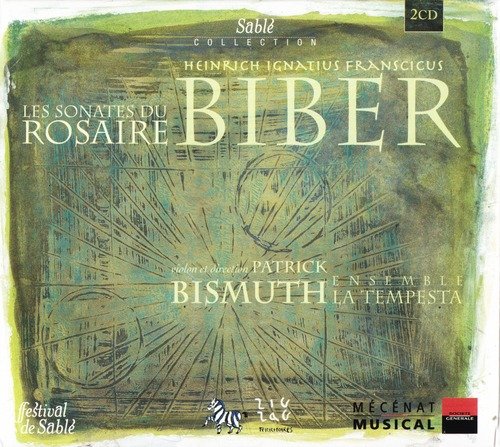Ensemble la Tempesta, Patrick Bismuth - Biber: Les Sonates du Rosaire (2003)

Artist: Ensemble la Tempesta, Patrick Bismuth
Title: Biber: Les Sonates du Rosaire
Year Of Release: 2003
Label: Zig Zag Territories
Genre: Classical
Quality: FLAC (image+.cue,log,scans)
Total Time: 01:58:14
Total Size: 750 mb
WebSite: Album Preview
Tracklist: Title: Biber: Les Sonates du Rosaire
Year Of Release: 2003
Label: Zig Zag Territories
Genre: Classical
Quality: FLAC (image+.cue,log,scans)
Total Time: 01:58:14
Total Size: 750 mb
WebSite: Album Preview
CD 1:
01 - 02: L'annonciation
03 - 06: La visite а Elisabeth
07 - 09: La naissance du Christ
10: La presentation au temple - Ciacona, Adagio, Presto, Adagio
11 - 14: Jesus au Temple - Sarabande, Double
15: Le Jardin des oliviers - Lamento, Adagio, Presto, Adagio, Adagio, Adagio
16 - 17: La Flagellation
18 - 20: La couronne d'epines
CD 2:
01 - 03: Le chemin de Croix
04 - 06: La Crucifixion
07 - 09: La Resurrection
10 - 12: L'Ascension
13 - 16: L'Esprit Saint
17 - 18: L'Assomption
19 - 21: Le Couronnement de la Vierge
22: L'Ange Gardien - Passacaglia, Adagio, Adagio
Performers:
Ensemble la Tempesta
Patrick Bismuth, violin
Just a generation ago, Heinrich von Biber's Rosary (or "Mystery") Sonatas were looked upon as ultra-rare repertoire, the sort of thing a Classical record collector would have to go out of his/her way to obtain on recordings. It appears that by now anyone who plays Baroque violin music to any degree of seriousness has had contact with Biber's sonatas, and there are no less than 20 complete or near complete recordings of Rosary Sonatas available. Make that 21 with Zig Zag Territories' Biber: Les Sonates du Rosaires, featuring violinist Patrick Bismuth with continuo provided by the ensemble La Tempesta.
The eight-member La Tempesta provides a thicker continuo texture than is usually reserved for these works, which can be performed as solo violin music. Patrick Bismuth does not favor the thin tone commonly employed by period instrumentalists, nor does he fuss over ornamentation. He plays with a rich, full-bodied, almost Romantic tone, which makes his interpretation closer to that of the first players to record the Rosary Sonatas, like Susanne Lautenbacher. This approach may be a plus or a minus depending on how one likes the Rosary Sonatas served up. However, it should be noted that Bismuth concentrates on the beauty and linearity of Biber's masterwork as opposed to its eccentricity, and this performance never quite catches fire. Likewise, despite the name of the ensemble, La Tempesta is under Bismuth's leadership and never become "tempestuous," preferring to provide a soft-focus backdrop for Bismuth to sail over.
The recording, made in the Church of the School of St. Geneviève in Versailles, is good, although at times the organ seems too heavy and one wants it to back off the violin a bit. Zig Zag Territories' Biber: Les Sonates du Rosaires is fully functional as a recording of Biber's Rosary Sonatas and is very nicely packaged. Nevertheless, if one already has a favorite version of this work, say from John Holloway, Romanesca, Gabriela Demeterová, or another artist, the Bismuth is unlikely to unseat it.
The eight-member La Tempesta provides a thicker continuo texture than is usually reserved for these works, which can be performed as solo violin music. Patrick Bismuth does not favor the thin tone commonly employed by period instrumentalists, nor does he fuss over ornamentation. He plays with a rich, full-bodied, almost Romantic tone, which makes his interpretation closer to that of the first players to record the Rosary Sonatas, like Susanne Lautenbacher. This approach may be a plus or a minus depending on how one likes the Rosary Sonatas served up. However, it should be noted that Bismuth concentrates on the beauty and linearity of Biber's masterwork as opposed to its eccentricity, and this performance never quite catches fire. Likewise, despite the name of the ensemble, La Tempesta is under Bismuth's leadership and never become "tempestuous," preferring to provide a soft-focus backdrop for Bismuth to sail over.
The recording, made in the Church of the School of St. Geneviève in Versailles, is good, although at times the organ seems too heavy and one wants it to back off the violin a bit. Zig Zag Territories' Biber: Les Sonates du Rosaires is fully functional as a recording of Biber's Rosary Sonatas and is very nicely packaged. Nevertheless, if one already has a favorite version of this work, say from John Holloway, Romanesca, Gabriela Demeterová, or another artist, the Bismuth is unlikely to unseat it.
DOWNLOAD LINKS

![Sibel Köse Septet - In Good Company (2025) [Hi-Res] Sibel Köse Septet - In Good Company (2025) [Hi-Res]](https://www.dibpic.com/uploads/posts/2025-12/1765846644_uizwujac4ht2d_600.jpg)

![Betty Carter - The Music Never Stops (2019) [Hi-Res] Betty Carter - The Music Never Stops (2019) [Hi-Res]](https://www.dibpic.com/uploads/posts/2025-12/1765896843_bcmn500.jpg)

![Demo Rumudo - Second Nature (2025) [Hi-Res] Demo Rumudo - Second Nature (2025) [Hi-Res]](https://www.dibpic.com/uploads/posts/2025-12/1765883076_cover.jpg)
![Coco Chatru Quartet - Lost Christmas (2025) [Hi-Res] Coco Chatru Quartet - Lost Christmas (2025) [Hi-Res]](https://www.dibpic.com/uploads/posts/2025-12/1765719561_coco-chatru-quartet-lost-christmas-2025.jpg)
![Afrodream - Guiss Guiss (2025) [Hi-Res] Afrodream - Guiss Guiss (2025) [Hi-Res]](https://www.dibpic.com/uploads/posts/2025-12/1765638325_a2717494732_0.jpg)
